E-Museum of Pyrographic ArtAntique Art Hall
|
| - Café Flambé - | - Portraits and Paintings - | - Decorative and Applied Art - |
| - Folk and Traditional Art - | - Antique Art - | - Special Hall - | - Sculpture - |
| - Children's Hall - | - Bookstore and Library - | - Tools and Techniques - |
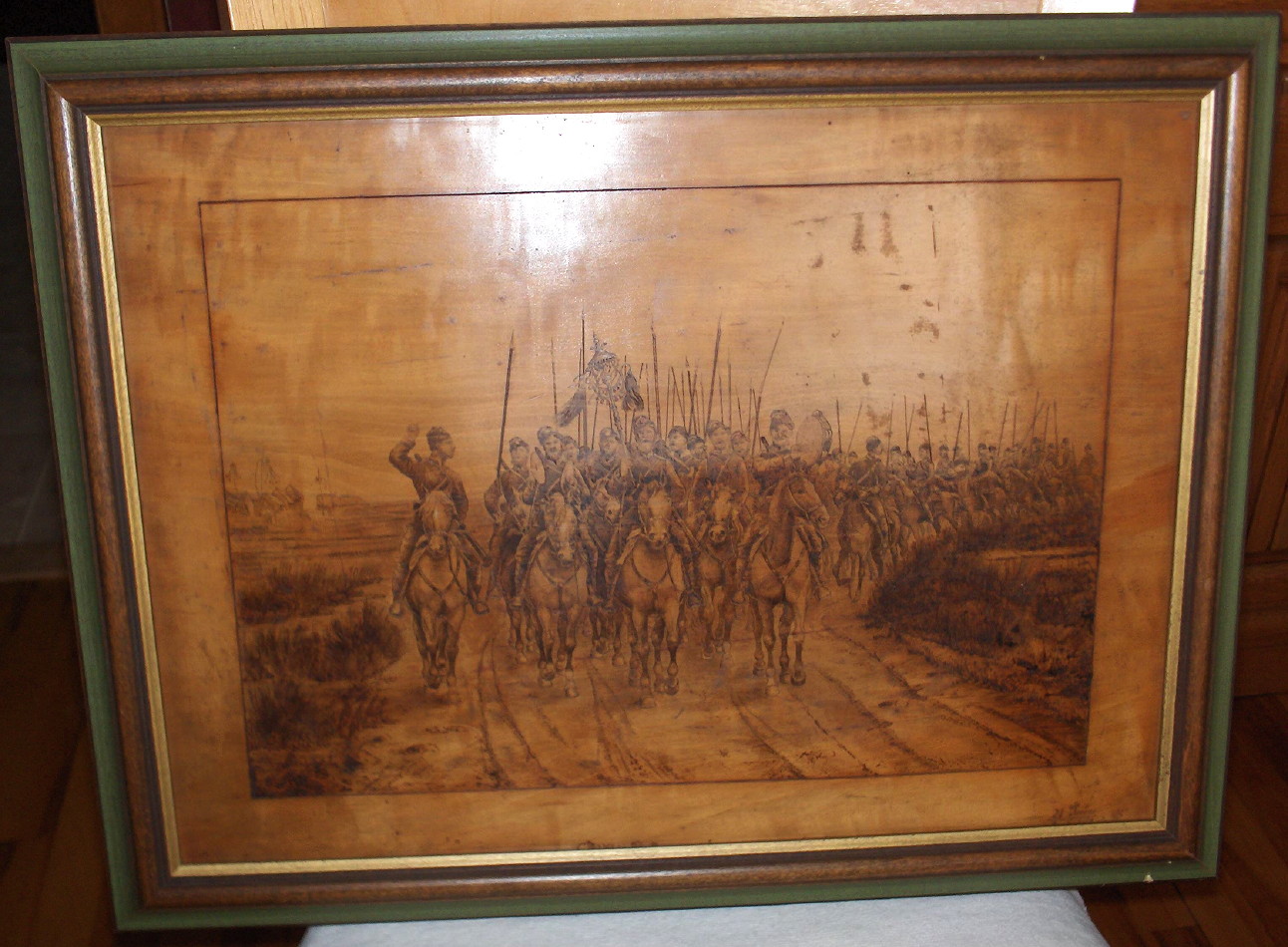 |
| The Cossacks of the Imperial Guard By Count Waléry de Rottermund, circa 1895 Pyrography on wood panel, approximately 19 in. wide by 14 in. tall (inside frame) and approximately 21.25 in. wide by 16.25 in. tall (outside frame) After the 1889 painting of that title by Edouard Détaille Image thanks to the owner |
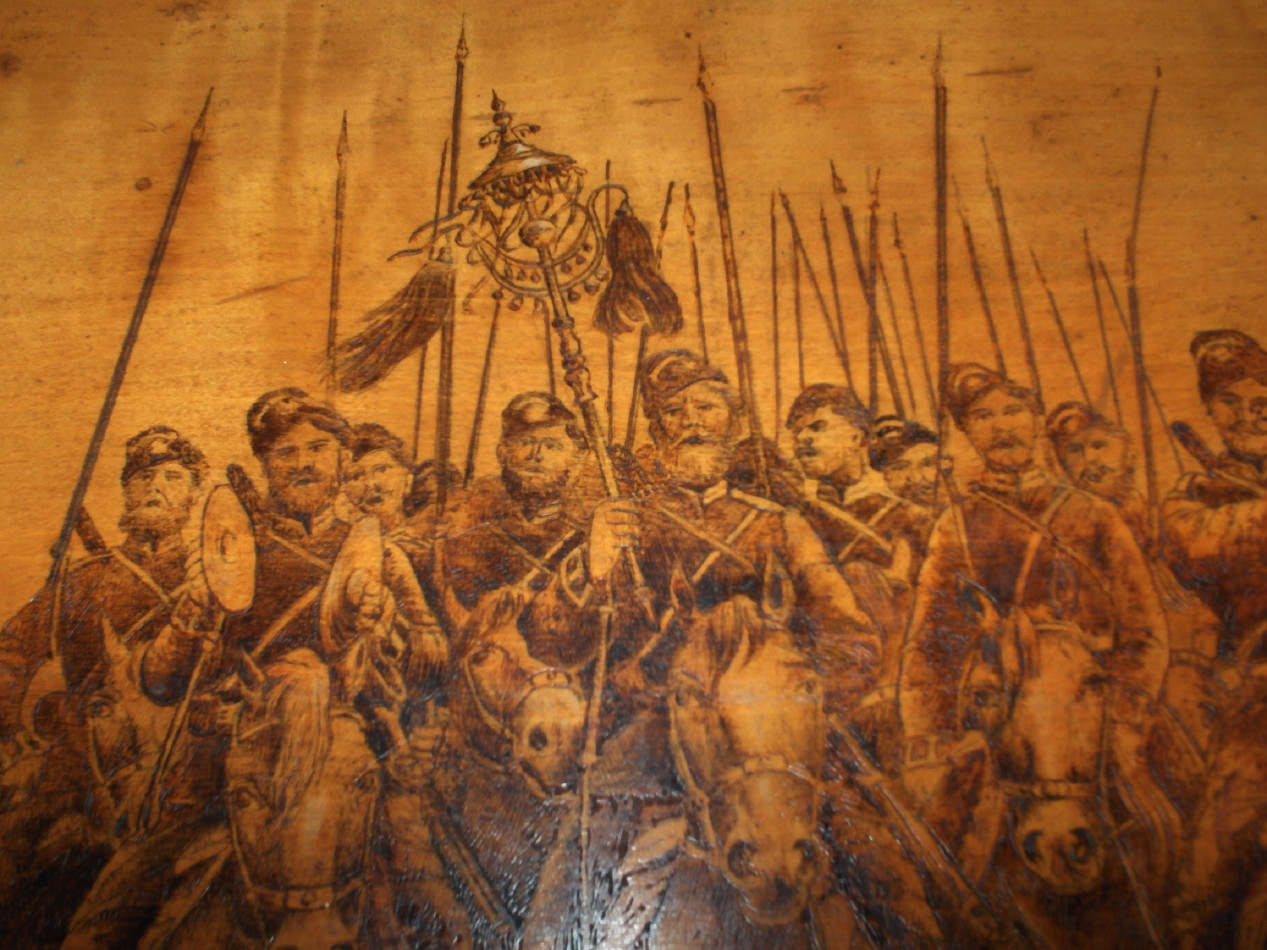 |
| The Cossacks of the Imperial Guard, Detail By Count Waléry de Rottermund, circa 1895 Pyrography on wood panel, approximately 19 in. wide by 14 in. tall (inside frame) and approximately 21.25 in. wide by 16.25 in. tall (outside frame) After the 1889 painting of that title by Edouard Détaille Image thanks to the owner |
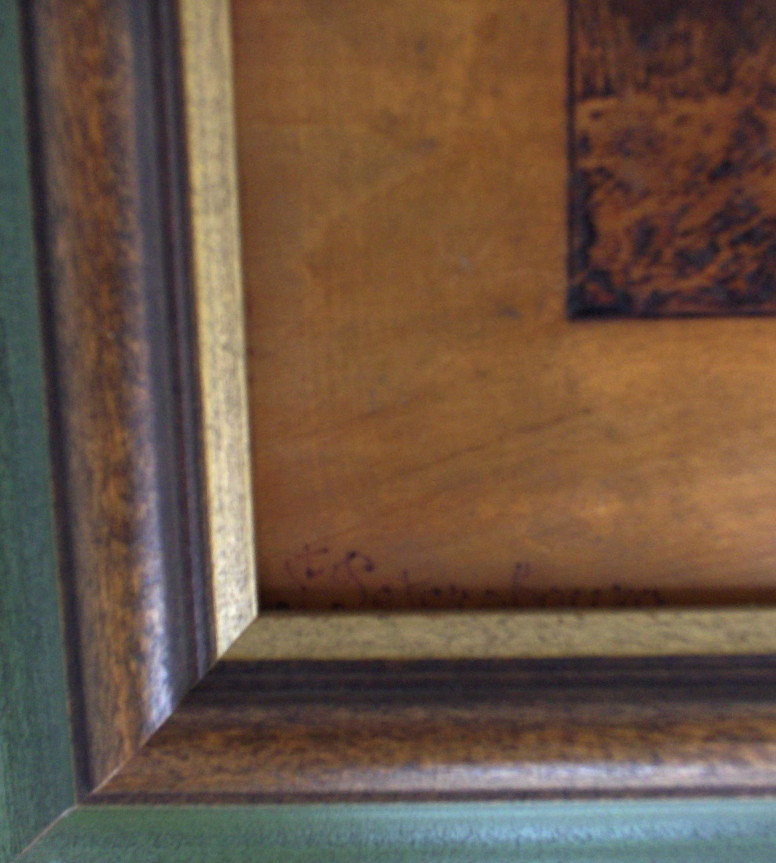 |
| The Cossacks of the Imperial Guard,
Detail of the inscription lower left, recto, "St Petersbourg" By Count Waléry de Rottermund, circa 1895 Pyrography on wood panel, approximately 19 in. wide by 14 in. tall (inside frame) and approximately 21.25 in. wide by 16.25 in. tall (outside frame) After the 1889 painting of that title by Edouard Détaille Image thanks to the owner |
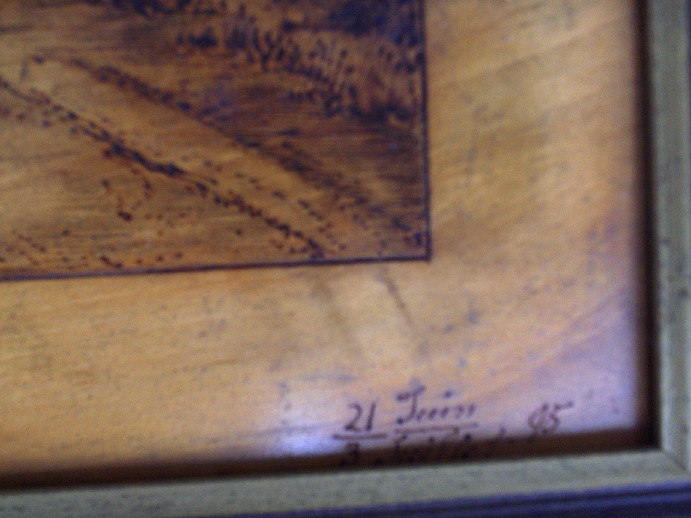 |
| The Cossacks of the Imperial Guard,
Detail of the inscription lower right, recto, "21 Juin / 3 Juillet 95 By Count Waléry de Rottermund, circa 1895 Pyrography on wood panel, approximately 19 in. wide by 14 in. tall (inside frame) and approximately 21.25 in. wide by 16.25 in. tall (outside frame) After the 1889 painting of that title by Edouard Détaille Image thanks to the owner |
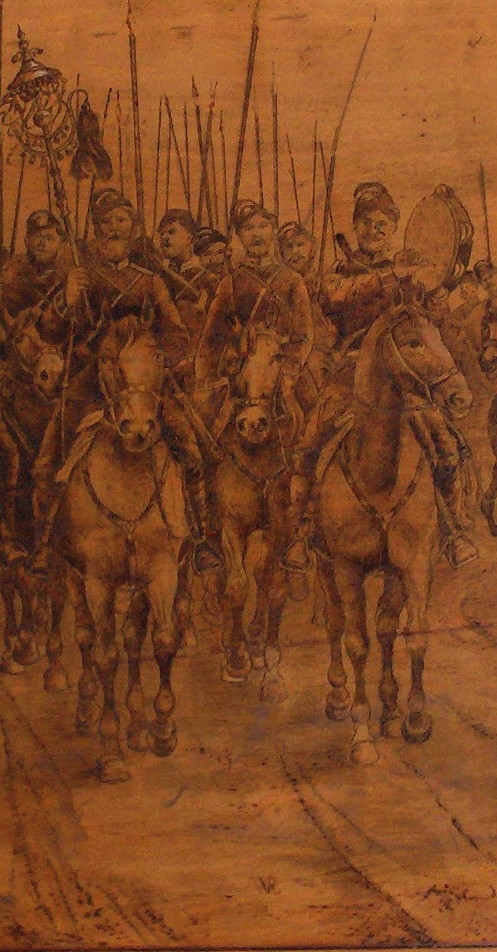 |
| The Cossacks of the Imperial Guard,
Detail of central figures and monogram WR in the lower center, in the artwork itself By Count Waléry de Rottermund, circa 1895 Pyrography on wood panel, approximately 19 in. wide by 14 in. tall (inside frame) and approximately 21.25 in. wide by 16.25 in. tall (outside frame) After the 1889 painting of that title by Edouard Détaille Image thanks to the owner |
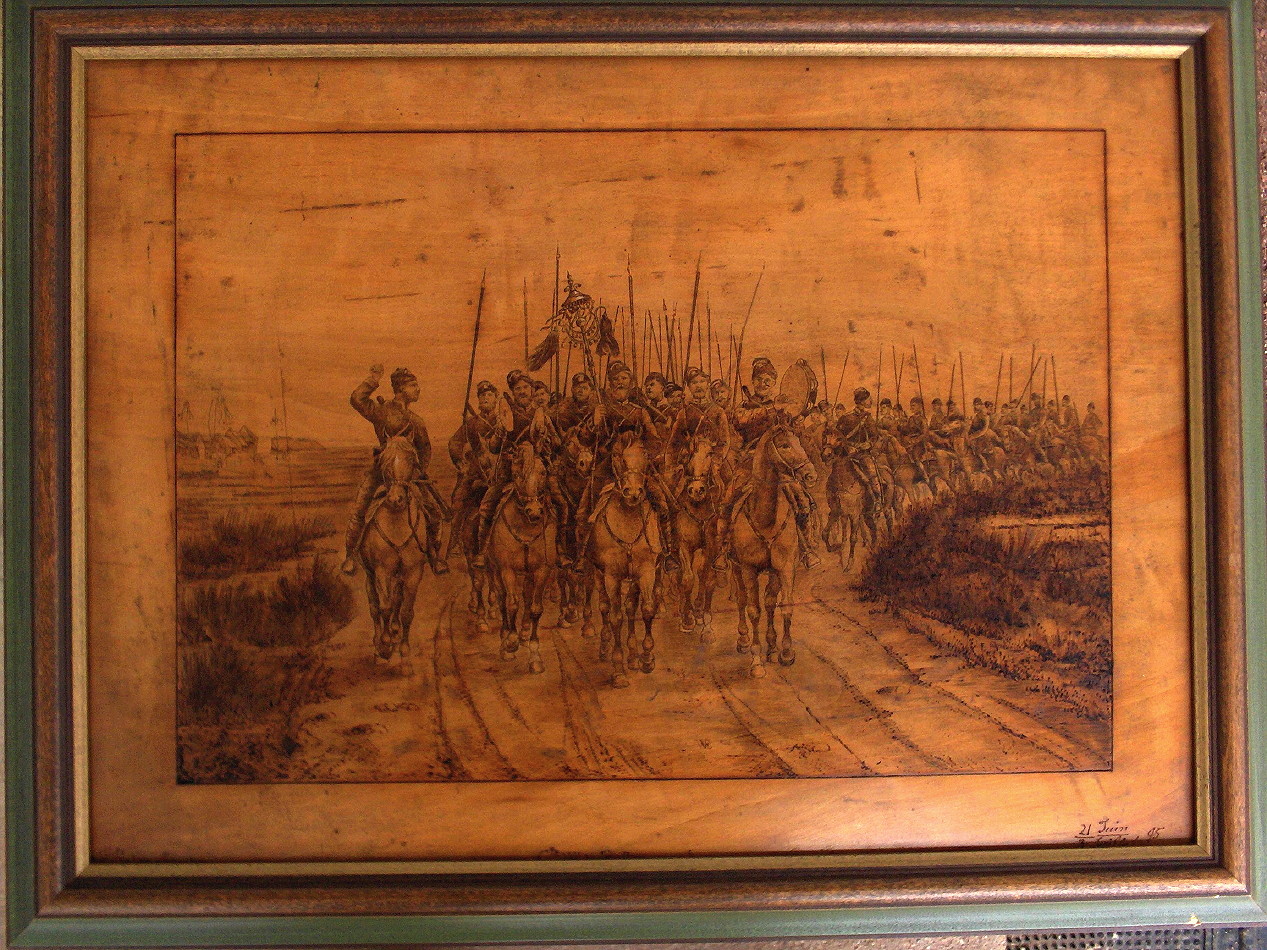 |
| The Cossacks of the Imperial Guard By Count Waléry de Rottermund, circa 1895 Pyrography on wood panel, approximately 19 in. wide by 14 in. tall (inside frame) and approximately 21.25 in. wide by 16.25 in. tall (outside frame) After the 1889 painting of that title by Edouard Détaille Image thanks to the owner |
The exhibit here of "The Cossacks" is of the only known work by
Count Waléry de Rottermund that is not in a museum.
Little is known of the Polish-born noble and artist, who lived out his life in Belgium after fleeing his homeland in 1830. According to one source, he was married to Josephine, the daughter of Henry Gilbert Claes, a former owner of Rullingen Castle in Borgloon, Belgium. [The link to the Count's name at the beginning of this paragraph is to a photographic portrait of him. The reference at the second link here (see the second paragraph there) does not say whether Josephine and Walery actually lived in the castle, although it seems likely they did. It is believed the Count did his pyrographic works in Belgium. The inscriptions on this one, which are all in French, support that assumption, as well.] Research has also revealed that in 1851, he bought the historic hotel in Spa, Belgium, called quaintly "At the City of Antwerp," renovated it to the status of a luxury hotel, and resold it a year later, at which time it became known as the Faller Hotel, named after its then new owner. Today it is called "Le Brittanique" and is a boarding school for boys.
The panel of "The Cossacks" exhibited here has various inscriptions. Since most were done on the outer edge at the bottom of the wood panel, they mostly disappear into the frame. In the lower left are the words "St Petersbourg" (the French spelling of the famous Russian city). In the center, barely discernible even by the owner who was able to view all of them when the panel separated slightly from the frame upon handling, was the Count's signature, written as "Cte. W. de Rottermund." And on the right, were the two mysterious dates written one (21 June "21 Juin") over the top of the other (3 July "3 Juillet") followed by 95. Conjecture has it that perhaps the dates represent the day Count de Rottermund began the pyrography and the date that he completed it. In addition to all of this, as was typical of this artist, a small, subtle monogram WR is there in the artwork itself, in the lower central part.
The uniform of a cossack in an early 20th Century photograph is identical to those of the horsemen in Count W. de Rottermund's pyrograph. It is likely that the Count worked from either a photogravure or an engraving of the famous painting, and it is also noted that his composition captures a narrower spectrum than Détaille's.
The oral history of the provenance of this Count Waléry de Rottermund panel
recounts that it was purchased in Russia in 1895 by American
Eva Wheaton Converse Painter (1874–1968) while in her travels there on the
occasion of her sister Emma's wedding to Alexander Boggs, on July 3rd, 1895,
at the American and British Church in Saint Petersburg, Russia. Boggs was
from North Carolina, and it is a family mystery why Emma and Alexander
married in Russia.
It was first questioned how the panel might have arrived in Russia from
Belgium; its Russian theme was thought to have been a factor. In light of
additional research in the Converse family that revealed the exact date
of the owner's trip for her sister's wedding, the interesting coincidence
that the date on the Count's pyrography panel of "The Cossacks"
is the same date as the wedding of Emma Converse to Alexander Boggs was
noted.
It was later discovered that the wood on the Count's panel is Russian birch,
which suggests an alternate scenario, i.e., that perhaps Count Waléry
de Rottermund was also in Russia at that time, and perhaps to attend the
very same wedding.
The panel of "The Cossacks" was later passed down to one of Eva
Wheaton Converse Painter's descendants, and finally to a friend of the
family in the United States.
There are four panels by Count Waléry de Rottermund in the world famous Pinto Collection:
Asiatic Battle Scene is one of a pair. Another, Sleigh Stand, with the theme of a Russian market scene, is likewise one of a pair. Whereas the four Count de Rottermund panels in the Pinto Collection are after paintings by Polish artist Alexander Orlowski (1777–1832), Count de Rottermund's panel "The Cossacks," exhibited here, is after a painting by the French military painter Edouard Détaille. [At the Edouard Détaille link, scroll down to the fourth image on that page to see his painting—with the story about the painting below it—and then, in the column to the right, go down to the eighth thumbnail image (entitled "Formal Reception") to see the same painting with more detail.]
An article entitled The Pinto Collection: Important 19th C. Pyrographic Artists highlights research and notes (including some on Count de Rottermund) by conservator Susan Millis on that collection, which is at the Birmingham Museums and Art Gallery in England.
If you have either any questions to ask or any information to offer regarding Count Waléry de Rottermund and his pyrography work, please e-mail the E-Museum Curator.
You are leaving the Count Waléry de Rottermund Salon.
You can return to the
Antique Hall
or visit one of the following:
Pyrographic Art Exhibit Halls:
Portraits and Paintings
Decorative and Applied Art
Sculpture
Traditional and Folk Art
Children's Pyrographic Art
Special Pyrographic Art
The Book Store and E-Museum Library
Pyrography Tools and Techniques
Your questions and comments are welcome and appreciated.
Please e-mail the E-Museum Curator
Back to E-Museum Entrance homepage
© 2011 Kathleen M. Garvey Menéndez, all rights reserved.
12 March 2011. Updated 19 March 2011. Last updated 7 September 2011.

